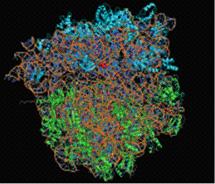Continuation of the popular review (fourth and last part) including the background to the decision of the Nobel Prize Committee in Chemistry to award the prize to the discoverers of ribosomes, including Prof. Ada Yonat from the Weizmann Institute

Dr. Moshe Nachmani (fourth and last part - from the 2009 Nobel Prize in Chemistry website)
The meaning of a pattern of millions of dense black dots
At the beginning of the nineties, the crystals made by Ada Yonat were of sufficient quality. The pattern of black dots was detailed enough to determine the exact position of the atoms in the ribosome crystal. However, she still remains a serious teacher. This was the "show problem" of X-ray crystallography (The entry in Wikipedia). In order to deduce the structure from the pattern of the black dots, the scientists need to know what the "phase angle" of each and every one of the dots is. This mathematical information is related to the position of the atoms in the crystal.
A trick often used by scientists to determine the incidence angles is to immerse the crystal in heavy atoms, such as mercury. The heavy atoms are attached to the surface of the crystalline ribosomes. By comparing the dot pattern from the crystals with the heavy atoms to the original one, the scientists are able to determine the angle of incidence.
However, since the ribosomes are so large, many heavy atoms are attached to them and it is difficult to immediately determine the angles of incidence. Therefore, additional information is required to resolve the instance problem.
In the end, the one who solved the problem was the scientist Thomas Streitz. He used images of the ribosome, obtained by another researcher (Joachim Frank) who is an expert in electron microscopy. With the help of these images, the researcher was able to determine how the ribosomes are organized in the crystal, but the resolution was not sufficient to "see" the individual atoms. This information, combined with the information obtained from the heavy atoms, eventually led to the determination of the incidence angles.
Summary after twenty years of research
In 1998, Thomas Streitz published the first crystal structure of the large subunit of the ribosome. The image of the building resembled a kind of dim photograph. In this image it was not possible to see the individual atoms, but it was possible to distinguish the RNA fragments. the length of the ribosome. It was a decisive breakthrough.
Now that the show problem was finally solved, all that was left was to improve the crystal and store more information to improve the sharpness of the resulting image. This year's Nobel bride and groom reached the finish line almost simultaneously. In the months of August and September of 2000, they published the crystal structures that had the resolution to decipher the positions of the atoms. Thomas Straits was able to obtain the structure of the large subunit from the bacterium Haloarcula marismortui. Ada Yunath Venkataraman Ramakrishnan obtained the structure of the small subunit of the bacterium Thermus thermophilus. Following this, it was possible to map the functionality of the ribosome at the most basic level, the atomic level.
Bacterial ribosome structure.
The rRNA fragments are colored orange, the small subunit proteins are colored blue, and the large subunit proteins are colored green. Antibiotic (in red) binds to the small subunit. Scientists are studying these structures in order to design and develop new and more effective antibiotic agents.
For the source of the review on the Nobel Prize website
To the first part of the review - from Darwin to Watson and Crick
To the second part - what is the ribosome
For the third part - Ada Yonat - the persistent pioneer
More of the topic in Hayadan:
- The work of Prof. Yonat made it possible to understand the mode of action of five antibiotic drugs
- Ada Yonat won the 2009 Nobel Prize in Chemistry
- For an interview with Ada Yonat that was published in Scientific American about a year ago - polar bears and drunken ribosomes
- The ribosome cracker - an interview for the Weizmann Institute magazine
- The mysteries of the peptide bond - Weizmann Institute magazine

One response
The complete guide to ribosomes for beginners is complete